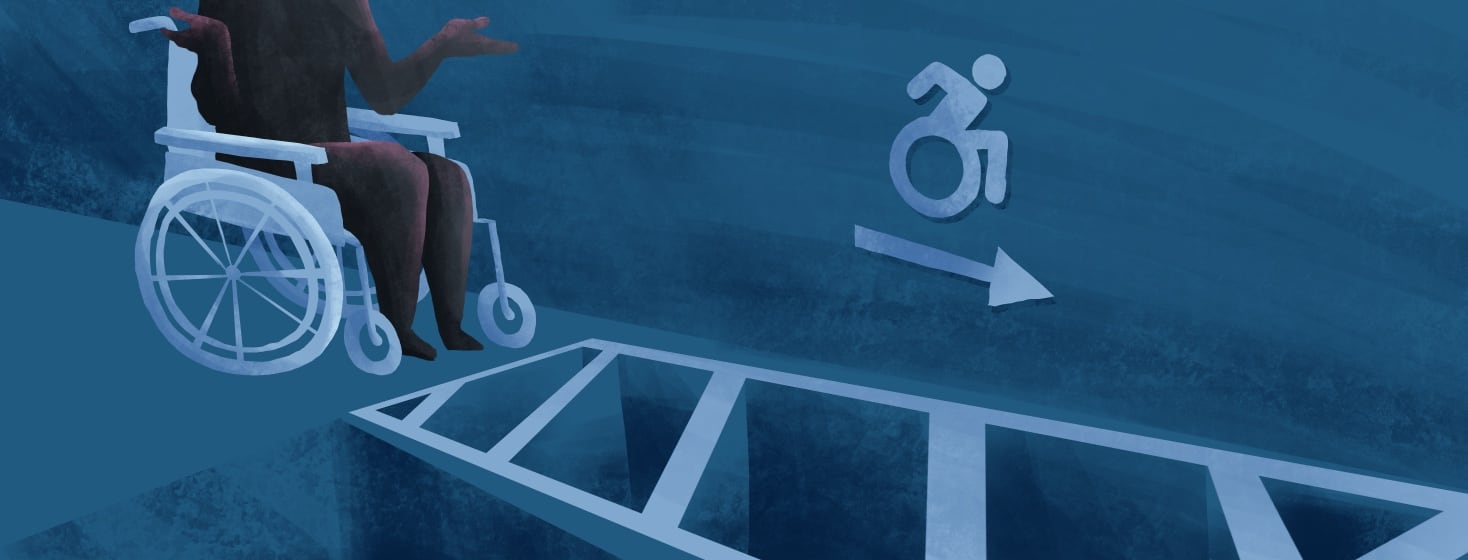Breaking Accessibility
People who don’t need accessibility often don’t notice it or don’t appreciate the tenuous nature of it.
They think any ramp is accessible or moving something to a different location is just as good. They think of accessibility as just "put it in" and "it works anywhere". They don’t understand the thinking behind accessibility, the planning that goes into it.
Accessibility is not one-size-fits-all
One ramp isn’t the same as another.
Some ramps are just as useless as a step because the angle is too steep to climb with a wheelchair. Or, the ramp doesn’t have enough room to turn at the top or bottom. Or, it’s a good ramp but is as slippery as a skating rink and impossible to get wheel traction.
Accessibility isn’t a one-size-fits-all ramp.
It’s about the thought behind it. What will work for the actual people using the accessibility? A ramp may work for my wheelchair, but can a blind person detect a texture change with their cane to know that a slope is coming?
Thoughtless changes have a big impact
Recently, I experienced a thoughtless accessibility change and had to navigate the consequences.
When the indoor pool I use for my aquatic therapy reopened with pandemic rules in October, I had to negotiate accessible access. It took a while, but we reached an agreement on accommodations.
Then, in mid-December, the ramped leisure pool I was using had to close due to a leak issue. It’s still closed 4 months (and counting) later for what seems like endless repairs.
So, they had to adjust and arrange for me to use the lap pool. They have a portable pool lift set up in the most shallow lane (still too deep for me to stand) in a corner that is away from the traffic of the regular lap swimmers.
The lap pool does not have ideal access
The lap pool is not ideal. It’s colder and too deep for me to do my water-walking exercise, but it is better than nothing.
The access is also a little trickier because it depends on a working pool lift. I had been using it a few weeks when the battery died and they had no replacement — so for a few days, I had no pool access and couldn’t do my aquatic exercises.
The response from the pool management felt, at best, like casual concern. So, I had to raise a ruckus to get them to find a new battery and reinstate my access. Only when I got angry and started citing the law did anything happen.
The accessible pool lift was moved
For several months, getting access to my aquatic exercises proceeded smoothly. Then, spring training for bringing on new lifeguards began and new problems arose.
The trainer decided that the best place to do some of the training activities was where I access the lap pool with the lift. Although the area on the other side of the pool was available, somehow where I exercise was preferred.
An unnecessary mess
So, the pool staff moved the lift. My husband and I arrived one day and found the lift moved to the opposite side of the pool and set up incorrectly. We had to spend a half-hour guiding them on correcting it.
Then, I had to adjust my aquatic routine because the positioning was still not the same and I couldn’t do my usual exercises.
When we were done and getting out, my wheelchair and the lift were in the way of all the other lap swimmers and we kept having to make way for them. It was a mess and completely unnecessary.
Little attention to accessibility issues
The regular guards working at the pool witnessed and appreciated the accessibility problems, but it seemed like they couldn’t say no to the outside trainer when the lift was then repeatedly moved back and forth during my subsequent exercise sessions.
Perhaps it was a tug of war conducted with a pool lift? It felt like little attention was being paid to the accessibility issues at the higher management level.
I sort of think of it as the elephant versus the lion. Who should move? Well, the lion because he’s easier to move. The elephant should just do their thing because their options are more limited.
Accessibility matters
Why destroy accessibility that is hard-fought and precariously arranged? Thoughtlessness.
The logic goes: well, there is only one person coming an hour for 3 visits a week. It’s no big deal. The lift works the same anywhere (never mind positioning, risk of breaking it, etc.).
We may be able to move easier, but we are more in number so we prioritize ourselves and don’t consider the many accessibility impacts on just one person. This person may not be able to exercise, but it’s not a priority to us.
Accessibility is precious and fragile
But accessibility matters. Without it working right, being implemented correctly — I am adrift with no access to the pool, not able to maintain my health, not able to exercise. Accessibility is easy to break and hard to create (or fix).
The pool lift has been moved back and the accessibility is working better for me to be able to do all my exercises (except water walking). But, I’m not sure how long that will last or if it will be thoughtlessly broken again.

Join the conversation